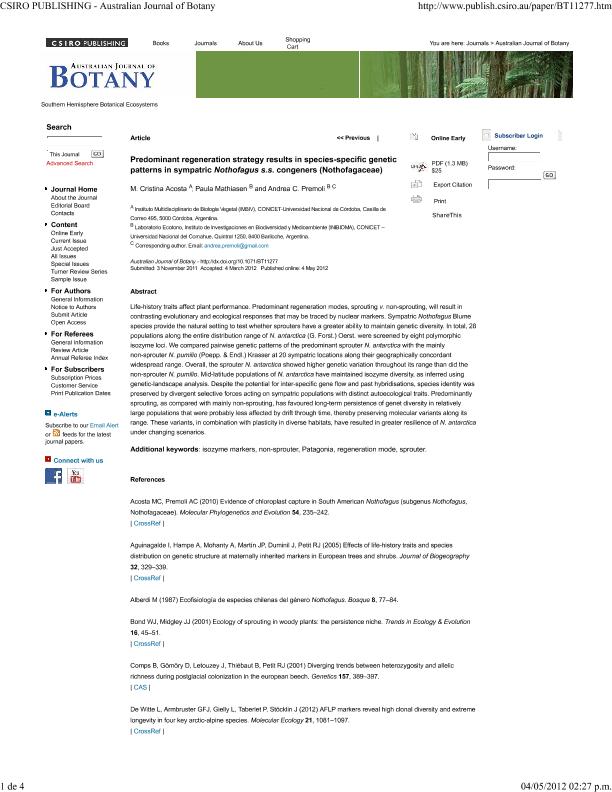Mostrar el registro sencillo del ítem
dc.contributor.author
Acosta, María Cristina

dc.contributor.author
Mathiasen, Paula

dc.contributor.author
Premoli Il'grande, Andrea Cecilia

dc.date.available
2017-06-06T14:50:25Z
dc.date.issued
2012-05
dc.identifier.citation
Acosta, María Cristina; Mathiasen, Paula; Premoli Il'grande, Andrea Cecilia; Predominant regeneration strategy results in species-specific genetic patterns in sympatric Nothofagus s.s. congeners (Nothofagaceae); Csiro Publishing; Australian Journal Of Botany; 60; 4; 5-2012; 319-327
dc.identifier.issn
0067-1924
dc.identifier.uri
http://hdl.handle.net/11336/17549
dc.description.abstract
Life-history traits affect plant performance. Predominant regeneration modes, sprouting v. non-sprouting, will result in contrasting evolutionary and ecological responses that may be traced by nuclear markers. Sympatric Nothofagus Blume species provide the natural setting to test whether sprouters have a greater ability to maintain genetic diversity. In total, 28 populations along the entire distribution range of N. antarctica (G. Forst.) Oerst. were screened by eight polymorphic isozyme loci. We compared pairwise genetic patterns of the predominant sprouter N. antarctica with the mainly non-sprouter N. pumilio (Poepp. & Endl.) Krasser at 20 sympatric locations along their geographically concordant widespread range. Overall, the sprouter N. antarctica showed higher genetic variation throughout its range than did the non-sprouter N. pumilio. Mid-latitude populations of N. antarctica have maintained isozyme diversity, as inferred using genetic-landscape analysis. Despite the potential for inter-specific gene flow and past hybridisations, species identity was preserved by divergent selective forces acting on sympatric populations with distinct autoecological traits. Predominantly sprouting, as compared with mainly non-sprouting, has favoured long-term persistence of genet diversity in relatively large populations that were probably less affected by drift through time, thereby preserving molecular variants along its range. These variants, in combination with plasticity in diverse habitats, have resulted in greater resilience of N. antarctica under changing scenarios.
dc.format
application/pdf
dc.language.iso
eng
dc.publisher
Csiro Publishing

dc.rights
info:eu-repo/semantics/openAccess
dc.rights.uri
https://creativecommons.org/licenses/by-nc-sa/2.5/ar/
dc.subject
Isozyme Markers
dc.subject
Non-Sprouter
dc.subject
Patagonia
dc.subject
Regeneration Mode
dc.subject
Sprouter
dc.subject.classification
Otras Ciencias Biológicas

dc.subject.classification
Ciencias Biológicas

dc.subject.classification
CIENCIAS NATURALES Y EXACTAS

dc.title
Predominant regeneration strategy results in species-specific genetic patterns in sympatric Nothofagus s.s. congeners (Nothofagaceae)
dc.type
info:eu-repo/semantics/article
dc.type
info:ar-repo/semantics/artículo
dc.type
info:eu-repo/semantics/publishedVersion
dc.date.updated
2017-05-31T15:37:09Z
dc.journal.volume
60
dc.journal.number
4
dc.journal.pagination
319-327
dc.journal.pais
Australia

dc.journal.ciudad
Collingwood
dc.description.fil
Fil: Acosta, María Cristina. Consejo Nacional de Investigaciones Científicas y Técnicas. Centro Científico Tecnológico Conicet - Córdoba. Instituto Multidisciplinario de Biología Vegetal. Universidad Nacional de Córdoba. Facultad de Ciencias Exactas Físicas y Naturales. Instituto Multidisciplinario de Biología Vegetal; Argentina
dc.description.fil
Fil: Mathiasen, Paula. Consejo Nacional de Investigaciones Científicas y Técnicas. Centro Científico Tecnológico Conicet - Patagonia Norte. Instituto de Investigaciones En Biodiversidad y Medioambiente. Universidad Nacional del Comahue. Centro Reg.universidad Bariloche. Instituto de Investigaciones En Biodiversidad y Medioambiente; Argentina
dc.description.fil
Fil: Premoli Il'grande, Andrea Cecilia. Consejo Nacional de Investigaciones Científicas y Técnicas. Centro Científico Tecnológico Conicet - Patagonia Norte. Instituto de Investigaciones En Biodiversidad y Medioambiente. Universidad Nacional del Comahue. Centro Reg.universidad Bariloche. Instituto de Investigaciones En Biodiversidad y Medioambiente; Argentina
dc.journal.title
Australian Journal Of Botany

dc.relation.alternativeid
info:eu-repo/semantics/altIdentifier/url/http://www.publish.csiro.au/paper/BT11277.htm
dc.relation.alternativeid
info:eu-repo/semantics/altIdentifier/doi/http://dx.doi.org/10.1071/BT11277
Archivos asociados
